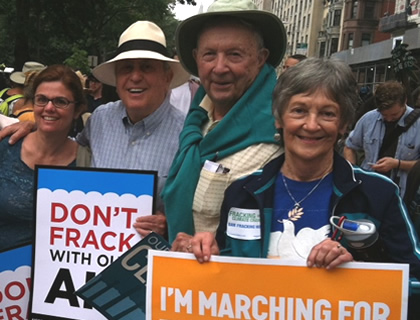
The hand holding out the button was gnarled and shaking. Its owner, his head crowned with an abundance of curly white hair, mumbled something about the button. My friend, standing near this man, exclaimed, “This is cool.” On the button an image of the earth was held in two hands, one of which was large, the other small, as if a father or grandfather was passing the planet to a child.
At the People’s Climate March in New York City on September 21, many young people marched. They carried many different signs, but one we saw frequently announced, “I’m marching for my future.” One of my friends carried a sign declaring, “I’m marching for my grandchildren.” And, we saw many of those, as well.
Occasionally a chant – call and response – floated above the heads of marchers. “What is democracy?” they called, and the response, “This is democracy.” As I looked around, the multitude of various faces seemed to acknowledge this truth. Young, old, and in-between marched. We saw people with babies, and at least one person in a wheelchair. People or every color, leftover hippies and their 21st century versions, groups from every environmental orientation, anti-war protesters, members of labor unions, campaign workers, college students, Buddhists, vegans, communists and so many others I lost count, moved around us as we walked.
“Noah’s Ark” was perhaps the most powerful image for me from the March. The ark, which was large enough to hold many people, emerged from a street to slide in amongst the marchers. Aboard the ark were a rabbi, a priest, an atheist, a Wiccan, and on and on. “We are all in this together,” it announced.
Since returning home I have been reflecting on this experience and how the teachings of yoga guide us in living consciously and in harmony with life on this planet. It seems to me two of the yama recommended in the Yoga Sutra, in particular, can help us. The first and most important attitude recommended is ahimsa or non-harming. It is interpreted to be more than a prohibition against violence; it requires, as well, positive action so that we treat all beings – and I believe that includes the living earth – with respect and benevolence.
The other yama especially relevant as we reflect on how to live in balance is aparigrahah. This yama is translated as non-covetedness or an absence of greed. It requires living simply, taking only what is necessary.
These teachings offer antidotes to many of the attitudes that have brought us to such a critical point in the life of the planet and her inhabitants. They are part of a larger group of recommendations that if adhered to offer a chance to live with greater peace and joy.
As a way of living more consciously in harmony with life on this planet and with ourselves, we can ask ourselves questions raised by these teachings.
- Is there more that I can do to practice ahimsa, bringing an attitude of respect and kindness to others, to all beings, to how I live day to day?
- Do I live consciously with an attitude of moderation, resisting excesses of consumption or acquisition?
- Can I live more simply, generously, keeping in mind that how I live each day affects, not just those around me, but those throughout the world?